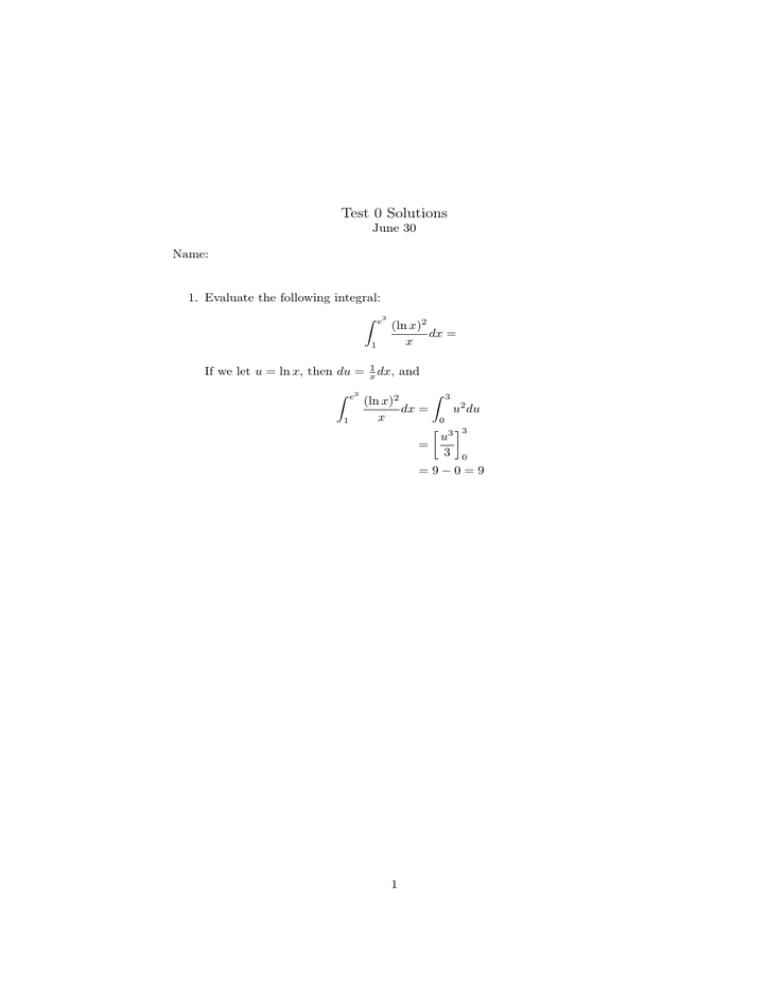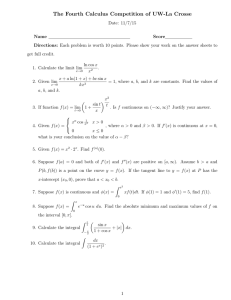Test 0 Solutions
advertisement

Test 0 Solutions June 30 Name: 1. Evaluate the following integral: Z 1 e3 (ln x)2 dx = x If we let u = ln x, then du = x1 dx, and Z 1 e3 (ln x)2 dx = x Z 3 = u3 3 u2 du 0 3 0 =9−0=9 1 2. Find an antiderivative: Z sin(πt) cos(πt)dt = If we let u = sin(πt), then du = π cos(πt)dt, and Z Z u sin(πt) cos(πt)dt = du π u2 +C = 2π sin2 (πt) = +C 2π 2 3. Put the following quantities in order, from least to greatest. Briefly explain your choices. A= B= Z π/2 cos(t)dt Z0 π cos(t)dt 0 C= Z 3 Z 6 Z 3π/2 cos(t)dt 0 D= cos(t)dt 0 E= 0 E, D, B, C, A 3 cos(t)dt 4. Let K= Z 4 3x2 dx −9 (a) Give an approximation for K with 39 rectangles and left endpoints. (b) Is your approximation an underestimate or an overestimate? Explain why. (c) Express K as a limit of sums. (a) 38 X 1 i=0 3 1 · 3(−9 + i)2 3 (b) The approximation is an overestimate. We are overestimating from -9 to 0, and underestimating from 0 to 4, but overall we are overestimating. (c) K = lim n→∞ n X 13 i=1 4 n · 3(−9 + 13 2 i) n 5. Do two of the following four problems: (a) Find all points on the graph of the function f (x) = 2 sin(x) + sin2 (x) at which the tangent line is horizontal. (b) Find the derivative of the function f (x) = x3 at x = 1 directly from the definition. (c) Evaluate lim x→π esin x − 1 x−π (d) Find an equation of the tangent line to the curve y = ex cos x at the point (0, 1). (a) The points where the tangent line is horizontal are the points where f ′ (x) = 0, i.e. where 0 = 2 cos(x) + 2 sin(x) cos(x) = 2 cos(x)[1 + sin(x)] Thus the tangent line is horizontal when 2 cos(x) = 0 (at x = or when sin(x) = −1 (at x = 3π 2 + 2πn). π 2 +πn) (b) (1 + h)3 − 13 h→0 h 13 + 3 · 12 · h + 3 · 1 · h2 + h3 − 1 = lim h→0 h 3h + 3h2 + h3 = lim h→0 h = lim 3 + 3h + h2 f ′ (1) = lim h→0 =3 (c) Use L’Hopital’s Rule: lim x→π cos(x)esin x esin x − 1 = lim x→π x−π 1 = cos πesin π = −1 · 1 = −1 (d) By the product rule, y ′ (0) = −e0 sin(0) + cos(0)e0 = 0 + 1 = 1 Thus the tangent line passes through (0, 1) and has slope 1. An equation for this line is y = x + 1. 5 6. Let f be a differentiable, non-constant, function with the property that Z x f (t)dt = [f (x)]2 0 What function is f ? If we differentiate the integral, by the Fundamental Theorem, we get f(x). Thus differentiating both sides with respect to x, we get f (x) = 2f (x)f ′ (x) Thus 0 = f (x)[2f ′ (x) − 1], which implies f (x) = 0 or f ′ (x) = 1/2 for all x. Since f is non-constant, it can’t be identically 0, and thus f (x) = x/2 + C. Plugging back into the original equation, we find C = 0, and so conclude f (x) = x/2. 6




